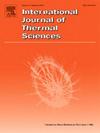金属聚能射流在自由飞行中的辐射加热提高其极限伸长率
IF 4.9
2区 工程技术
Q1 ENGINEERING, MECHANICAL
International Journal of Thermal Sciences
Pub Date : 2025-04-12
DOI:10.1016/j.ijthermalsci.2025.109930
引用次数: 0
摘要
实验表明,预先加热聚能装药的内衬可以提高聚能装药的侵彻效果。这种增加的原因是由于其材料的热软化而形成的聚能射流的极限伸长率增加。考虑了在自传播高温合成的化学反应过程中,利用聚能装药前管的热辐射和管内放热在自由飞行中加热射流本身的可能性。基于均匀细长圆柱棒一维非定常导热轴对称问题的解析解,研究了热辐射加热聚能射流的特性。结果表明,在铜质聚能射流的塑性破裂之前,在自由飞行中对其进行辐射加热,使其达到可以预期射流穿透作用有所增加的温度是可能的。本文章由计算机程序翻译,如有差异,请以英文原文为准。
Increasing the ultimate elongation of metal shaped-charge jets by their radiation heating in free flight
According to experiments, preliminary heating the liner of the shaped charge allows to increase its penetration effect. The reason for this increase is an increase in the ultimate elongation of the formed shaped-charge jet due to thermal softening of its material. The possibility of heating the jet itself in free flight by thermal radiation of a tube located in front of the shaped charge with heat release in tube, provided by the course of a chemical reaction of self-propagating high-temperature synthesis, is considered. The features of heating shaped-charge jets by thermal radiation are investigated on the basis of an analytical solution of one-dimensional axisymmetric problem of nonstationary heat conductivity for a uniformly elongating cylindrical rod. It is shown that radiation heating of copper shaped-charge jets in free flight is possible, until their plastic break up, to a temperature that allows one to expect some increase in the penetrating effect of the jet.
求助全文
通过发布文献求助,成功后即可免费获取论文全文。
去求助
来源期刊

International Journal of Thermal Sciences
工程技术-工程:机械
CiteScore
8.10
自引率
11.10%
发文量
531
审稿时长
55 days
期刊介绍:
The International Journal of Thermal Sciences is a journal devoted to the publication of fundamental studies on the physics of transfer processes in general, with an emphasis on thermal aspects and also applied research on various processes, energy systems and the environment. Articles are published in English and French, and are subject to peer review.
The fundamental subjects considered within the scope of the journal are:
* Heat and relevant mass transfer at all scales (nano, micro and macro) and in all types of material (heterogeneous, composites, biological,...) and fluid flow
* Forced, natural or mixed convection in reactive or non-reactive media
* Single or multi–phase fluid flow with or without phase change
* Near–and far–field radiative heat transfer
* Combined modes of heat transfer in complex systems (for example, plasmas, biological, geological,...)
* Multiscale modelling
The applied research topics include:
* Heat exchangers, heat pipes, cooling processes
* Transport phenomena taking place in industrial processes (chemical, food and agricultural, metallurgical, space and aeronautical, automobile industries)
* Nano–and micro–technology for energy, space, biosystems and devices
* Heat transport analysis in advanced systems
* Impact of energy–related processes on environment, and emerging energy systems
The study of thermophysical properties of materials and fluids, thermal measurement techniques, inverse methods, and the developments of experimental methods are within the scope of the International Journal of Thermal Sciences which also covers the modelling, and numerical methods applied to thermal transfer.
 求助内容:
求助内容: 应助结果提醒方式:
应助结果提醒方式:


